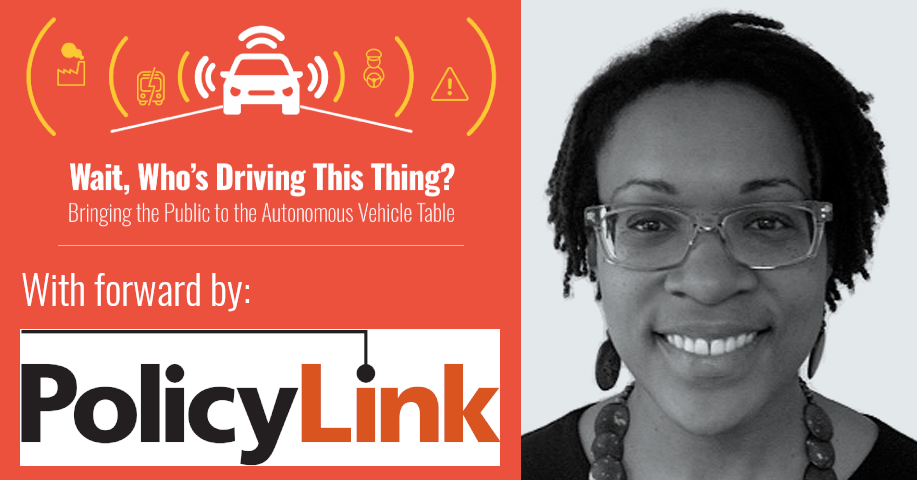
It did not take much time for Pittsburghers for Public Transit to come to a decision about who to invite to write a forward to the organization’s new Literature Review on the impact of Autonomous Vehicle technology, “Wait, Whos Driving This Thing?: Bringing the Public to the Autonomous Vehicle Table”.
Anita Cozart, Senior Director at PolicyLink, has been doing important justice-oriented policy work at the intersection of race, mobility, and economics. Her work and that of her team at PolicyLink have been leading the conversation about how to ensure equity and human rights in a time where private investment is rapidly flowing into both the development of urban neighborhoods and new transportation technology.
Pittsburghers for Public Transit was honored when Anita accepted our invitation to author a forward to this Literature Review because we both agree: conversations about new technology need to begin with the people who will be most affected by them.
Read Anita’s forward below, and read the full copy of “Wait, Who’s Driving This Thing?: Bringing the Public to the Autonomous Vehicle Table”.
“Charting a New Course for Urban Mobility” by Anita Cozart, Senior Director at PolicyLink
Everyone deserves to live in a healthy, safe and inclusive community with affordable and accessible transportation that connects them to jobs, schools, health care, grocery stores, and more. Over the past few years, private sector leaders and some local officials in Pittsburgh and other cities have championed the idea of autonomous vehicle technology as a means to deliver on that vision.
The history and the future of our nation tells us that, as we consider integrating such technology into their transportation systems, community members must be at the table. Our historic transportation policies and investments, fueled by structural racism, have saddled communities of color with burdens including longer travel times, higher costs, environmental damage and illness. And, as we move toward a future in which by 2040, the U.S. will be a majority people of color nation, in order to realize a vision of healthy communities and shared prosperity, we must ensure that community has voice and agency in shaping the way we move through our neighborhoods, cities and regions.
The findings from Wait, who’s Driving this Thing? are a reminder that when it comes to transportation, we should embrace the “curb-cut effect”1. Curb cuts in sidewalks were originally developed to accommodate people in wheelchairs, but they benefit a broad swath of people. This concept can be applied in other areas of infrastructure (or the built environment): the most vulnerable transportation users should be the focus for the plans that are developed to integrate autonomous vehicle technology in cities. Simply put, the priorities of the most vulnerable communities should drive transportation policy and planning in our cities.
A national coalition of more than 100 groups dedicated to advancing racial equity into transportation policy, the Transportation Equity Caucus has developed a set of principles that can be used to consider the benefits and harms of automated vehicle (AV) deployment:
Create affordable transportation options for all people.
The cost of using AV for daily travel must be accessible for all incomes, particularly if they are to be an extension of the public transportation system.
Ensure fair access to quality jobs, workforce development and contracting opportunities in the transportation industry.
Jobs and contracts that come from the growth of AV must be accessible to workers and firms who have historically been shut out, namely people of color and people with disabilities. Economic security and new work opportunities should be prioritized for people working in sectors that will be eliminated due to AV deployment.
Promote, healthy, safe and inclusive communities.
Just like there are food deserts, there are transportation innovation deserts. Many communities of color are the last ones to have access to on-demand rides, bikes, and scooters. As AV is deployed, it is important to assess the spatial distributions of affordable transportation options using a racial equity lens.
Invest equitably and focus on results.
It is important to ensure that bias is not embedded in the computer algorithms that drive automated vehicle technology, and that rigorous data privacy regulations, which are currently lacking, are put in place. To ensure equitable outcomes, people of color and people with disabilities must be co-designers of the deployment of AV in cities.
Let’s take the wisdom from this report and chart a new course for urban mobility that is centered on ensuring that our most vulnerable in society can benefit from transportation innovation.